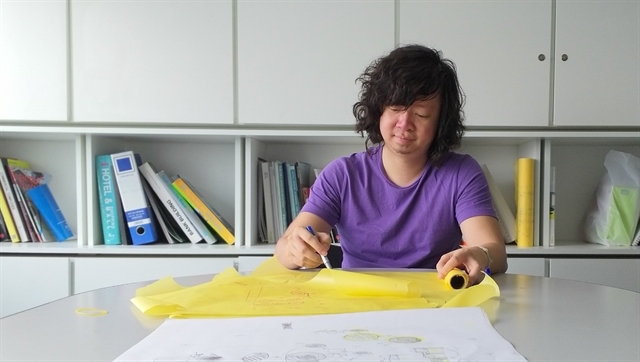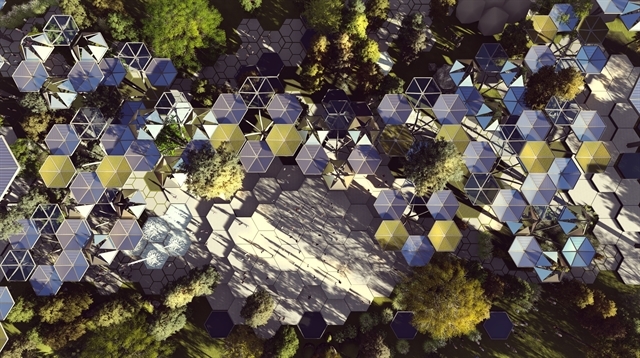 |
| MPN + Partners co-founder Nguyễn Phúc Minh |
The firm’s co-founder, young architect Nguyễn Phúc Minh who used to work at one of the top architecture firm called Foster + Partners, talks to Khánh Chi about the young firm’s philosophy, objectives and more.
As a young firm, how does MPN + Partners stand out from the crowd?
First and foremost, we are different because of the way we work. We've studied how the work of artisans, sculptors and musicians mingle with that of architects. Any project must satisfy three criteria: emotional touch, functionality and uniqueness. For each particular project, there are reasons and analyses behind it. That’s to say uniqueness means no ‘copy and paste’. Referring to the ‘best architecture designs’ available on the internet is not allowed as it creates a very bad habit. Once the impact of reference pictures is ingrained in our subconsciousness forever, there will be no creativeness at all.
Second, it’s our policy that we put forward at least three options for any project, or even five for those we are really interested without client's request. Normally, an architecture firm presents only one option to save time and human resources to help them make a quick profit. The options are different in terms of big idea, story, concept and analysis.
Third, it’s about sustainability in the construction and usage period. If you use materials from afar, for example from the US, which means you have to ship and transport them from a long way, the process will cause lots of impacts on the environment due to emissions, plus additional costs.
Energy-saving and sustainable projects are good for our future generations due to reduced emissions from our current activities. In this regard, we always have a consultant, usually from the US or India, who follows a project from the very beginning. Once a client/investor finalises their choice, the consultant will put forward energy criteria, for example, how to save 35 per cent of electricity/water per year. We help investors reduce costs whilst ensuring that sustainability will bring complete comfort to users.
Fourth, we do not follow the regular scope of architectural design that consists of five stages: concept – basic design – design development – construction drawing – sight supervision. We've renamed as we changed the design method and added another two stages free for clients to help reduce costs. In these two additional steps once the client approves a design, we sit down with them to see how we can have potential savings to update into the design.
Last but not least, we apply the following model for the Vietnamese market. A firm usually only cares about structure, and mechanical and electrical engineering, but not about things such as traffic, energy, noise, pedestrian comfort, and so on. Architecture is a combination of expertises that you cannot do alone if you want high quality. Architecture is a living thing not a box where human beings can go in and out, so we work always collaborating with consultants globally during a design process.
 |
| Indian National War Museum - Third prize |
Elements like history and culture are significant for a project, particularly when it stands beside those made by local architects. Is this true in the case of your award-winning designs?
These two elements create familiar emotions for users. For an architecture project designed in the US or India, for instance, a foreigner can see images of the US or India as soon as they approach it. Elements like culture, history and the specific features of a particular location must be shaped in the minds of architects from the very first stage of idea exploration. Studies also come from self analyses involving these elements. Each location has its own natural, cultural and historical context so projects are completely different from each other. That’s why referring to the best designs available is unacceptable.
To kick-start a project, we let our architects spend two days out, which means they do not come to the workplace but do whatever they want outside, even sleeping or having coffee during the day. But when they return to the office the following day, they must be able to present their emotions and rough ideas. In their presentations, they speak about the sound, colour, nature and general architecture of the area [where the project will take shape].
How is technology interwoven with these elements?
Technology gives us solutions as we always reach for green, environmentally friendly and energy-saving projects. Architecture team will think of a big idea of a technological system, whilst it is the consultants, for example in energy efficiency, that recommend solutions and mechanism, from whom we often combine with to “create” technologies applicable to a particular project.
Could you elaborate on your award-winning projects?
Standing next to American and Indian architects to receive the awards, we felt so proud to say “I’m from Việt Nam!” It meant a lot. We want to promote the reality that Vietnamese architects can compete with their foreign peers. For example, with India’s National War Museum competition, the first and second prizes went to local architects and we won third place. The Indian Prime Minister chose the best three projects. The Indians are quite conservative but he still chose ours.
We don’t consider Việt Nam our sole market. We look beyond borders. Thanks to these competitions we have successfully made our name. Competitions are there to find the best ideas.
For the award-winning designs, we felt really happy with our work. We are glad that we've been able to reach overseas clients. Patience and luck have driven us to this stage.
However, we always tell staff to not rest on their laurels and keep trying harder, just like fishing.
Known as a company built and staffed by young architects, is it an ideal playground?
With its ‘like no other’objective such as no quick profit, no resource limit and quality first, the company is there for young people. We respect young people and always tell our staff that “for an architecture firm to stay sustainable, trust must be formed among staff as trust is the foundation of success”.
For us, interns and experienced architects enjoy fair treatment, which means inexperienced youngsters can really do their jobs, present and discuss ideas with even international experts who have been in the field for years.
Flexible time in a flexible workplace is something I believe is really attractive to employees in order to balance their office and social life. For instance, if one works overtime voluntarily to meet a deadline, they will have the same time off the following day to recharge and kill stress (if any). Additionally, workers are entitled to 12 days off during the year, but our employees have 21 days instead.
Every Friday afternoon, we organise an open workshop where staff can make presentations on various topics like soft skills, photography and happiness. These activities help people change their world views, stay connected and promote sharing. VNS
 Established in 2012 with a people-focused design philosophy, MPN + Partners has earned international awards including third prize for the Seine Restaurant (France), Third National War Museum (India), and runner-up for DomestiCity (Altanta, US).
Established in 2012 with a people-focused design philosophy, MPN + Partners has earned international awards including third prize for the Seine Restaurant (France), Third National War Museum (India), and runner-up for DomestiCity (Altanta, US).